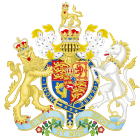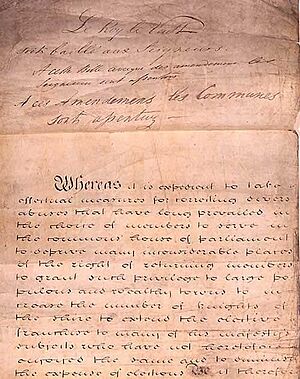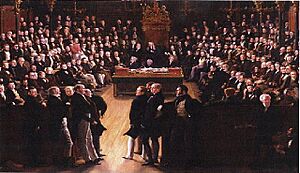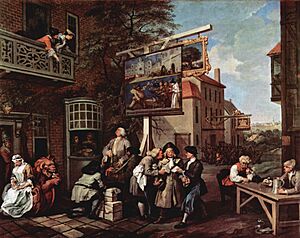Reform Act 1832 facts for kids
| Act of Parliament | |

|
|
| Long title | An Act to amend the representation of the people in England and Wales |
|---|---|
| Citation | 2 & 3 Will. 4. c. 45 |
| Introduced by | Lord Grey, Prime Minister |
| Territorial extent | England and Wales In Scotland and Ireland, the Scottish Reform Act 1832 and Irish Reform Act 1832 applied, respectively. |
| Dates | |
| Royal assent | 7 June 1832 |
| Other legislation | |
| Repealed by | Representation of the People Act 1948 |
| Relates to | Reform Act 1867 |
|
Status: Repealed
|
|
| Text of statute as originally enacted | |
| Corporate Property (Elections) Act 1832 | |
|---|---|
| Act of Parliament | |

|
|
| Long title | An Act to prevent the Application of Corporate Property to the Purposes of Election of Members to serve in Parliament. |
| Citation | 2 & 3 Will. 4. c. 69 |
| Other legislation | |
| Repealed by | Representation of the People Act 1949 |
|
Status: Repealed
|
|


The Representation of the People Act 1832 is also known as the Reform Act 1832 or the Great Reform Act. It was a very important law passed by the Parliament of the United Kingdom. This Act made big changes to how people voted in England and Wales.
Before this Act, the way people voted was very unfair. Many areas had very few voters but still elected members of Parliament (MPs). Some areas had many people but no MPs at all. The Act tried to fix this by giving more MPs to big cities. It also allowed more men to vote by changing the rules about owning property. However, it was the first law to officially say that only male people could vote, which meant women were not allowed.
The Act was proposed by the Whigs, led by Prime Minister Lord Grey. Many people, especially the Tories, were against it. But public pressure helped it pass. This law increased the number of voters from about 400,000 to 650,000. This meant about one in five adult men could now vote.
The full name of the Act is An Act to amend the representation of the people in England and Wales. Similar laws were passed for Ireland and Scotland in the same year.
Contents
How Voting Worked Before the Reform Act
Before the Reform Act, the House of Commons (one part of Parliament) had 658 members. Most of these members represented areas called boroughs. The rest represented counties.
Counties and Boroughs
Counties were large areas, and their MPs usually represented landowners. Boroughs were towns or cities, and their MPs were supposed to represent businesses.
The problem was that boroughs were very different in size. Some were big cities, but others were tiny villages. Many small boroughs, like Old Sarum, had very few voters. Sometimes, they had only a handful of people who could vote, but they still elected two MPs! These were called "rotten boroughs."
Who Could Vote?
The right to vote was called the "franchise." In counties, only men who owned land worth at least 40 shillings a year could vote. This rule had been around for a long time. Over the years, because of inflation, 40 shillings became worth less, so more people could meet this requirement. Still, most people could not vote. In 1831, only about 400,000 men in England could vote.
In boroughs, the rules for voting were even more confusing. They varied a lot:
- Some boroughs allowed "freemen" to vote (people who had special rights in the town).
- In others, you had to pay certain local taxes.
- Some required you to own a specific type of property called a "burgage."
- In some, only members of the town council could vote. These were often controlled by rich people.
- A few allowed any male householder (someone who could "boil a pot on his own hearth") to vote.
The biggest borough, Westminster, had about 12,000 voters. But many "rotten boroughs" had fewer than 100 voters. For example, Old Sarum had only about a dozen voters.
Women's Right to Vote
Before 1832, it was generally understood that women could not vote. However, the Reform Act of 1832 was the first law to specifically say that only "male persons" could vote. This made it clear that women were excluded. This specific wording later became a key reason why women fought for their right to vote.
Pocket Boroughs and Bribery
Many voting areas, especially those with few voters, were controlled by rich landowners. These were called "pocket boroughs" because they were "in the pocket" of their wealthy owners. These landowners could tell the voters who to choose, and if an MP didn't follow orders, they would lose their seat in the next election. For example, the Duke of Norfolk controlled eleven boroughs!

Bribery was also common. Voters were often paid to vote for a certain candidate. In some places, groups of voters would even sell their borough's votes to the highest bidder. Rich people who had made their money in British colonies, called "nabobs," sometimes used their wealth to buy control of boroughs.
The Push for Reform
People had been calling for changes to the voting system for a long time.
Early Efforts for Change
During the 1600s, after the English Civil War, some people wanted to give all men the right to vote. But this idea was rejected. Later, in the 1700s, Prime Minister Pitt the Elder called borough representation "the rotten part of our Constitution." He wanted to add more MPs for counties to balance the power. But Parliament didn't act on his ideas.
His son, William Pitt the Younger, also tried to bring about reform when he became Prime Minister. But King George III and many politicians were against it. So, his attempts failed too.
After the French Revolution
After the French Revolution in 1789, many British politicians became afraid of big political changes. They worried that reform could lead to chaos like in France.
Despite this fear, groups like the Society of the Friends of the People and the London Corresponding Society pushed for reform. In 1793, Charles Grey (who would later become Prime Minister) asked Parliament to look into reforms, but they refused.
Public demand for reform remained strong. In 1819, a large protest happened in Manchester, known as the Peterloo Massacre. Thousands of people gathered to demand voting rights. The military was sent in to break up the meeting, and many people were killed or injured. This event shocked the country and showed how serious the demand for reform was.
Passing the Reform Act
The First Reform Bill
When King George IV died in 1830, a new election was held. Voting reform became a major issue. Groups like the Birmingham Political Union formed to support reform, using peaceful protests and petitions.
The Prime Minister at the time, the Duke of Wellington, was strongly against any changes to the voting system. He believed the current system was perfect. His views were very unpopular, even within his own party. Less than two weeks later, he had to resign.
Lord Grey became the new Prime Minister and promised to reform Parliament. On March 1, 1831, the first Reform Bill was introduced. It aimed to get rid of 60 of the smallest boroughs and reduce the number of MPs in 47 others. It also gave more MPs to large cities and counties. The bill also made the rules for voting in boroughs the same for everyone and added about half a million new voters.
The bill passed its first big vote in the House of Commons by only one vote. But then, opponents made it difficult to pass. So, the government decided to hold another election to let the public decide.
The Second Reform Bill
In the election of 1831, people voted overwhelmingly for pro-reform politicians. The Whigs won a huge majority in the House of Commons. The Reform Bill was brought back, and this time it passed easily in the Commons.
However, when the bill went to the House of Lords, it faced strong opposition. Many Lords were against it, and they rejected the bill by 41 votes.
This rejection caused public anger and riots across the country. In places like Derby, Nottingham, and Bristol, people protested violently. In Bristol, rioters took control of the city for three days, destroying buildings.
The Third Reform Bill
After the riots, the government tried again. They brought forward the Third Reform Bill in December 1831. This new version was slightly different but still aimed to remove rotten boroughs and create new seats. It passed the House of Commons easily again.
When it went to the House of Lords, opponents tried to change the bill through amendments. Lord Grey's government then asked King William IV to create many new Lords who would support the bill. The King didn't want to do this, and Lord Grey resigned.
This led to a tense period known as the "Days of May." People feared a revolution. Protesters called for people to stop paying taxes and to withdraw their money from banks. The Duke of Wellington tried to form a new government but couldn't. So, the King had to ask Lord Grey to come back.
Eventually, the King agreed to create new Lords if needed. But the Duke of Wellington secretly told the opposing Lords to stop fighting the bill. Enough Lords then chose not to vote, allowing the bill to pass. The bill finally became law on June 7, 1832.
What the Reform Act Changed
Getting Rid of Seats
The main goal of the Act was to reduce the number of "nomination boroughs" (pocket boroughs).
- 56 of the smallest boroughs were completely abolished.
- 30 other small boroughs lost one of their two MPs.
- Weymouth and Melcombe Regis went from four MPs to two.
In total, 143 borough seats were removed in England.
Creating New Seats
In their place, the Act created 130 new seats in England and Wales:
- 26 English counties were split into two parts, each getting two MPs.
- 8 English counties and 3 Welsh counties got one extra MP.
- Yorkshire got two extra MPs.
- 22 large towns got two MPs each.
- 21 other towns (including two in Wales) got one MP each.
This meant 65 new county seats and 65 new borough seats were created. The total number of MPs in England went down slightly, while Wales gained a few. The exact borders of these new areas were set in a separate law.
Expanding the Right to Vote
The Act also changed who could vote:
- In counties, more types of landowners could vote, including those who rented land for a long time or paid at least £50 a year in rent.
- In boroughs, the rules were made the same: any male who rented a property (like a house or shop) worth at least £10 a year could vote, as long as they had lived there for at least 12 months.
- Some existing voters kept their right to vote for life, even if they didn't meet the new rules.
The Act also introduced a system for people to register to vote. It set up special courts to handle arguments about who could vote. It also allowed more than one place for voting in each area and limited voting to two days. Before, voting could last for up to fifteen days!
The Reform Act itself only applied to England and Wales. But similar laws were passed for Scotland and Ireland, which also increased the number of voters there.
Impact of the Reform Act
The Reform Act had a big impact on British politics.
The number of people who could vote in England increased from about 400,000 to 650,000. This was a jump of over 60%. However, it still meant that only about 7% of the population could vote.
Many important cities that had grown during the Industrial Revolution now got their own MPs. This led to new political battles between different groups, like the middle class and the working class. Having the right to vote encouraged many men to become more involved in politics.
In Scotland, the Act was even more revolutionary. The number of voters there jumped from 5,000 to 65,000, meaning 13% of adult men could now vote.
Tenant Voters
Many of the "pocket boroughs" that were removed belonged to the Tory party. To balance this, the Act gave the vote to tenants who paid £50 a year in rent. These tenants often voted as their landlords told them, and landlords usually supported the Tory party. This helped the Tories win elections in the years after the Act.
Historians say that the Act didn't hurt the power of traditional landowners in Parliament very much at first. They still had a lot of influence.
What the Act Didn't Fix
The Reform Act was a big step, but it didn't solve everything:
- Most working-class people still couldn't vote because of the property rules. This led to the rise of the Chartist Movement, which demanded more voting rights for men.
- A few "rotten boroughs" still remained.
- Bribery of voters continued to be a problem.
The Act did make the House of Commons stronger by reducing the power of wealthy Lords over elections. Some aristocrats worried that the government could now force them to pass any law by threatening to create new Lords. But the House of Lords still had a lot of power for many decades after 1832.
Future Reforms
After 1832, Parliament made some smaller changes, like limiting voting to one day. But for a long time, neither major political party pushed for big new reforms. They saw the 1832 Act as the final solution.
However, people continued to demand more voting rights. The Chartist movement, for example, wanted all men to vote, equal voting districts, and secret ballots. It wasn't until 1867 that Parliament passed the Second Reform Act, which made more big changes to the voting system.
The 1832 Act also didn't fix issues with local government boundaries, which were often very old and confusing. This led to more laws later on to reorganize county borders.
How Historians See the Act
Some historians believe the Reform Act of 1832 was the start of modern democracy in Britain. G. M. Trevelyan said that after 1832, "the sovereignty of the people" (meaning the power of the people) was truly established. Others argue that real democracy came later, with the 1867 Act or even later.
Many people in Parliament supported the Act because they hoped it would prevent even bigger, more radical changes. They thought a careful reform would be better than a revolution.
Historians today have different opinions on how important the Act was. Some say it had a huge impact, completely changing the political system and leading to modern political parties. They argue it "opened a door on a new political world." Others say its immediate effects were more limited, and that the aristocracy still held a lot of power for a long time.
Images for kids
-
William Pitt the Younger was a prominent advocate of parliamentary reform.
-
Poster issued by the Sheffield Typographical Society celebrating the passing of the Act.
-
Lord Grey (painted by George Hayter) headed the Whig ministry that ushered the Reform Bill through Parliament.
See also
- 1832 United Kingdom general election
- Elections in the United Kingdom § History
- List of constituencies enfranchised and disfranchised by the Reform Act 1832
- Reform Acts, other legislation concerning electoral matters
- Scottish Reform Act 1832, enlarged the electorate by a factor of 13 from 5,000 to 65,000






